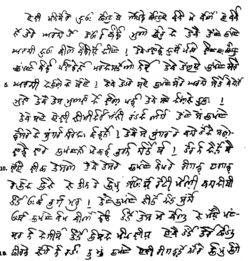Social:Mahasu Pahari
| Mahasu Pahari | |
|---|---|
| Mahasui | |
| 𑚢𑚩𑚭𑚨𑚰𑚃, महासुई | |
| Native to | India |
| Region | Himachal Pradesh |
| Ethnicity | Mahasu |
Native speakers | 1 million (2002)[1] |
Indo-European
| |
| Language codes | |
| ISO 639-3 | bfz |
| Glottolog | maha1287[2] |
Area
File:Mahasuvi Pahari sample.webm According to different locations, the language has developed several dialects. Lower Mahasu Pahari (Baghati, Baghliani, Kiunthali), Upper Mahasu Pahari (Rampuri, Rohruri, Shimla Siraji, Sodochi). The Kiunthali variety appears to be understood by others, and their attitude toward it is favorable. Rampuri is also called Kochi; Rohruri is also called Soracholi; and Sodochi is also known as Kumharsaini or Kotgarhi after the Kumarsain and Kotgarh areas of Shimla District respectively.[3] Intelligibility among dialects is above 85%. Lexical similarity is 74%–82% with upper dialects, and 74%–95% with lower dialects. The language is used in home and for religious purposes. It is understood and spoken from people of vital age group. The educated are more proficient in Hindi and English. It is considered to be highly endangered as the number of people speaking it is constantly going down. It is closely related to Sirmauri and to Jaunsari.
Script
The native script of the language is a variety of Takri Script. There are some written records of the language in Takri script and Nastaliq script but nowadays Devanagari script is usually used.
Phonology
Consonants
| Labial | Dental | Alveolar | Retroflex | Post-alv./ Palatal |
Velar | Glottal | ||
|---|---|---|---|---|---|---|---|---|
| Plosive / Affricate |
voiceless | p | t | ts | ʈ | tʃ | k | |
| aspriated | pʰ | tʰ | tsʰ | ʈʰ | (tʃʰ) | kʰ | ||
| voiced | b | d | dz | ɖ | dʒ | ɡ | ||
| breathy | bʱ | dʱ | ||||||
| Fricative | voiceless | s | ʃ | ɦ | ||||
| voiced | z | (ʒ) | ||||||
| Nasal | m | n | ɳ | (ŋ) | ||||
| Lateral | l | ɭ | ||||||
| Trill/Tap | r | ɽ | ||||||
| Approximant | ʋ | (j) | (w) | |||||
- Sounds [tsʰ bʱ dʱ] are only seldom heard among dialects.
- Allophones of /b d ɡ/ are heard as [b̥ d̥ ɡ̊] in word-final position.
- [tʃʰ] occurs from Hindi loanwords.
- [ʒ] can be heard as allophone of /dʒ/.
- [ŋ] is heard when a nasal occurs before velar stops.
- /ɦ/ may also be heard as a voiceless [h] among dialects.
- [j, w] are mainly heard after vowels. [w] can also be an allophone of /ʋ/.[4]
Vowels
| Front | Central | Back | |
|---|---|---|---|
| Close | i iː | u uː | |
| Mid | e eː | (ə) | o oː |
| Open-mid | ɛ | ɔ ɔː | |
| Open | ɑ ɑː |
| Front | Back | ||
|---|---|---|---|
| short | long | ||
| Close | ĩ | ũ | ũː |
| Mid | ẽ | õ | õː |
| Open-mid | ɔ̃ | ɔ̃ː | |
| Open | ɑ̃ | ɑ̃ː | |
- A short /u/ may also have an allophone of a near-close sound [ʊ].
- [ə] is mainly heard as an allophone of /ɑ/. /ɑ/ can also be heard as an open mid sound [ʌ].
Status
The language is commonly called Pahari or Himachali. The language has no official status and is recorded as dialect of Hindi.[5] According to the United Nations Education, Scientific and Cultural Organisation (UNESCO), the language is of definitely endangered category, i.e. many Mahasui children are not learning Mahasui as their mother tongue any longer.[6] Earlier, the language had state patronage. Everything changed since independence, due to favoritism towards Hindi by the Indian Government.
The demand for the inclusion of 'Pahari (Himachali)' under the Eight Schedule of the Constitution, which is supposed to represent multiple Pahari languages of Himachal Pradesh, had been made in the year 2010 by the state's Vidhan Sabha.[7] There has been no positive progress on this matter since then even when small organisations strive to save the language and demand it.[8] Due to political interest, the language is currently recorded as a dialect of Hindi, even when having a poor mutual intelligibility with it.
References
- ↑ Mahasu Pahari at Ethnologue (18th ed., 2015)
- ↑ Hammarström, Harald; Forkel, Robert; Haspelmath, Martin, eds (2017). "Mahasu Pahari". Glottolog 3.0. Jena, Germany: Max Planck Institute for the Science of Human History. http://glottolog.org/resource/languoid/id/maha1287.
- ↑ Mallikarjun, B. (2002-08-02). "Mother tongues of India according to the 1961 census". Language in India 2. http://www.languageinindia.com/aug2002/indianmothertongues1961aug2002.html. Retrieved 2023-07-23.
- ↑ Jouanne, Thomas (2014). A preliminary analysis of the phonological system of the Western Pahārī language of Kvār. University of Oslo.
- ↑ "Indian Language Census". https://censusindia.gov.in/2011Census/Language-2011/Statement-1.pdf.
- ↑ "Endangered Language (Mahasui)". https://www.theguardian.com/news/datablog/2011/apr/15/language-extinct-endangered.
- ↑ "Pahari Inclusion". Zee News. https://zeenews.india.com/news/himachal-pradesh/hp-for-inclusion-of-pahari-language-in-eighth-schedule_615857.html.
- ↑ "Pahari Inclusion". The Statesman. https://www.thestatesman.com/cities/demand-for-pahari-as-language-in-8th-schedule-of-constitution-1479046804.html.
External links
- Grierson's language divisions of Shimla on Twitter
- Western Pahari languages on Facebook
- Map of Western Pahari languages from Grierson's early 20th-century Linguistic Survey of India
 |




